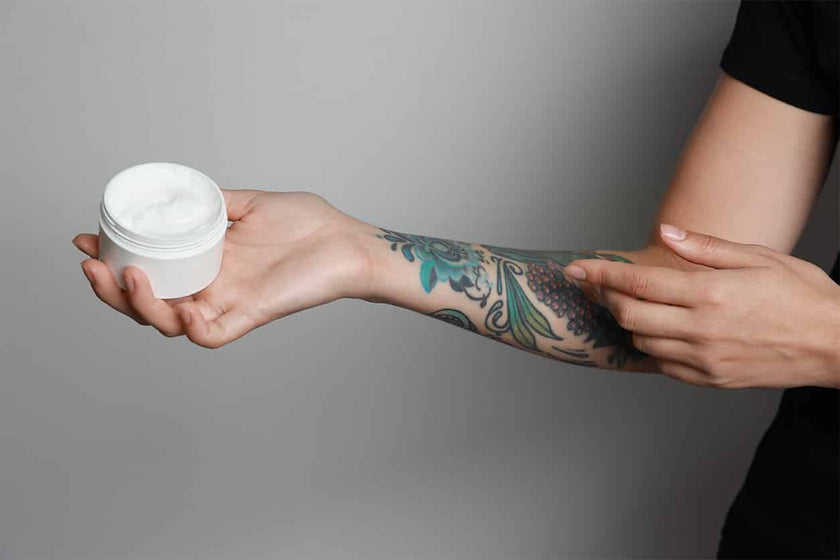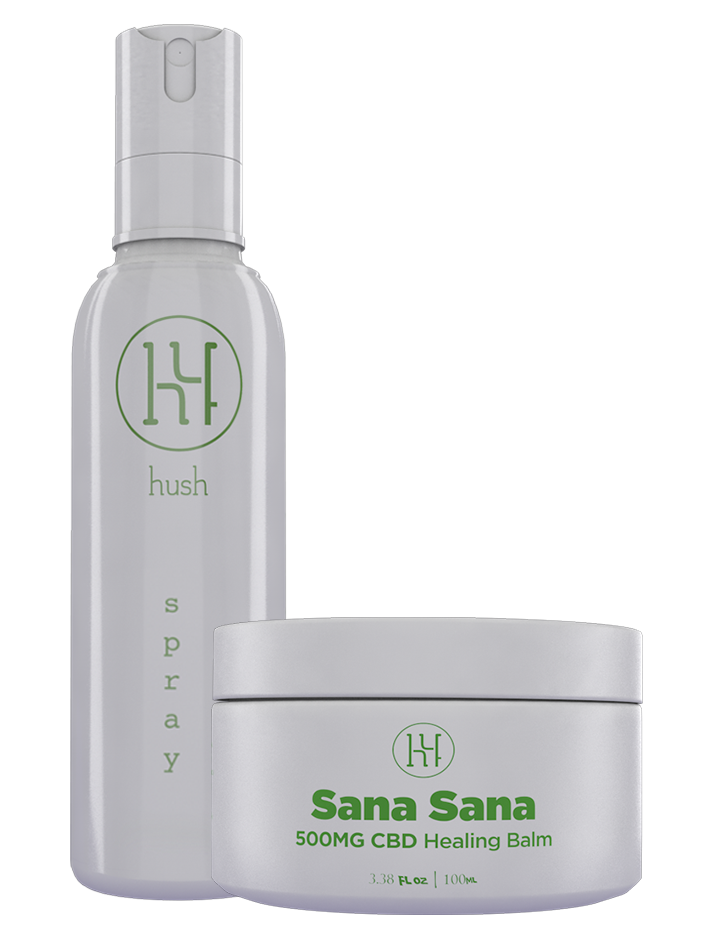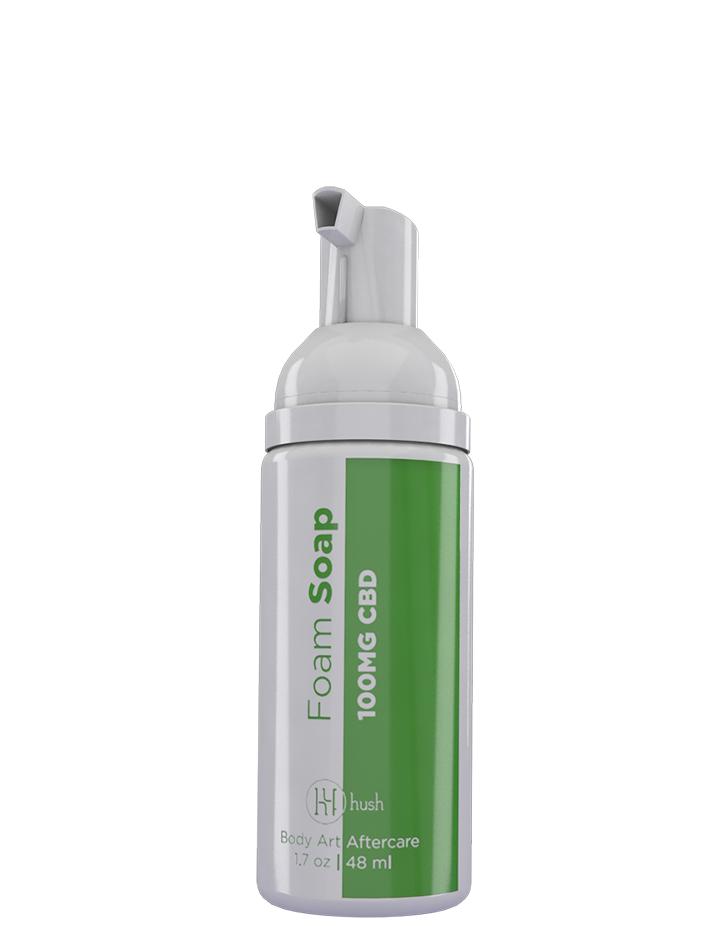The best tattoo aftercare soap is the one that gets the job done, is affordable, and doesn’t irritate your skin. We will not waste your time by telling you what you need to buy (although we do have some helpful products), but we will tell you everything you need to know about the type of soap to use and why.
Why Do You Need Tattoo Aftercare Soap?
Everyone knows that keeping a new tattoo clean is critical to avoid infection. There are soaps specifically formulated for tattoo aftercare, which cause less irritation. Your skin is already agitated from the tattoo process, so there’s no need to irritate it further. Regular soaps usually contain harsh ingredients such as fragrance and alcohol that burn your delicate skin. Ouch! So, before you flaunt your new ink, keep scrolling to learn the tattoo aftercare basics.
How To Wash Your Tattoo Safely
We have to start by saying that you should follow the aftercare steps your tattoo artist recommends. Everyone’s skin is different, heals differently, and reacts differently. The size of your tattoo, the placement, and the colors of ink used can all affect the healing process.
Step 1: Remove the Bandage
Generally, your artist recommends that you wait 24 hours before washing your new tattoo. If you are still wearing the bandage, carefully remove it after the first day, unless otherwise instructed. Peel away the bandage and dispose of it in a trash can, then wash your hands with antibacterial soap. Tip: You may find dried plasma, blood, or ink on the dressing. This oozing is a normal part of the healing process as dead skin cells slough themselves from the wound (gross, but true). If dried matter on the bandage and the dressing is stuck, simply wet the bandage with a small amount of water until the debris loosens.
Step 2: Wash and Dry the Tattoo
Carefully and gently wash the tattoo with lukewarm water and HUSH CBD foam soap, or another antimicrobial or antibacterial soap while you’re waiting for ours to arrive 😉 Never use a loofah, washcloth, sponge, or another abrasive item on the tattoo, because this can cause irritation and possible bleeding. Massage the soap into the tattoo carefully with your clean hands, rinse with warm water, and pat dry with a lint-free towel. A lint-free towel helps prevent lint, fuzz, or other particles from becoming stuck and dried to the tattoo. Keep it clean!
Step 3: Apply Moisturizer
Next, make sure those hands are clean so you don’t spread germs to the wound. Once you’ve washed your hands (because we don’t know where they’ve been), apply a moisturizer over your clean, dry tattoo. Gently massage a thin layer of HUSH Sana Sana healing balm or another fragrance-free, alcohol-free moisturizer on the tattoo and allow it to sink into your skin. Moisturizer provides a skin barrier to keep the tattoo moisturized and keep germs out. Reapply a clean bandage if your tattoo artist recommends you do so.
Step 4: Shield It From the Sun
The American Academy of Dermatology recommends you always wear SPF 30 or higher on your tattoo to shield it from the sun’s harmful rays. The sun can burn this delicate skin, so wear loose, cotton clothing and sunscreen when you are outdoors, at all times. And please, do not use tanning beds or tanning lotions during your tattoo healing time. That tan can wait. Mineral sunscreens are recommended for new tattoos because they do not contain chemicals. Sunscreen prevents damage to new tattoos, and for older tattoos, it prevents color fading. Wearing sunscreen every day is a good habit you need to form if you haven’t already. If not for your skin health, then for the sake of your new ink. Complete these steps two times per day unless instructed otherwise by your artist.
What Should I Look For in a Tattoo Aftercare Soap?
You may find shopping for a tattoo aftercare cleaner difficult. Here are a few things to look for when you’re choosing your tattoo aftercare soap:
-
If you have pre-existing skin allergies, read the ingredient label to ensure the soap does not contain compounds you are allergic to.
-
Use an antibacterial or antimicrobial soap. This type of soap kills all those germs and bacteria that can try to battle their way into your wound. Be on the defensive and stop these germs before they have that fighting chance.
-
Always choose a fragrance-free soap. The fragrance can be an irritant that causes the skin to burn and delays the healing process.
-
Choose an alcohol-free soap, por favor. It’s no mystery that alcohol burns open wounds, so there is no reason to cause yourself such discomfort. Just don’t do it.
-
The soaps formulated for tattoo aftercare specifically treat tattoos with the utmost care by design. These soaps are pH balanced for the delicate skin, so it isn't overly drying. Check out the HUSH CBD Foam Soap that removes bacteria and blood to keep the healing process on track. It is epinephrine-free and vegan, sourced from American hemp farms containing no GMOs or pesticides. Your tattoo artist may have a soap they also recommend, so ask. But if not, we have you covered.
What Tattoo Aftercare Soap Terms Should I Know?
We get it. Ingredient labels contain long words that are difficult to pronounce. Here are a few terms you will see on some of the best tattoo soap labels. We’ve included their descriptions and whether you can use them to clean your new tattoo so you are well-equipped for your next ink sesh.
Antibacterial vs. Antimicrobial
The main difference between an antibacterial soap and an antimicrobial soap is the organisms they kill. Antimicrobial soaps kill a broader spectrum of microbes than antibacterial soaps. Bacteria, mold, mildew, viruses, and algae don't stand a chance with antimicrobial soaps, but antibacterial soaps only kill bacteria (hence the name). Benzalkonium chloride (BAC) — now isn’t that hard to pronounce — is a common antimicrobial ingredient that fights against viruses, bacteria, and fungi. Either type of soap does the job of cleaning tattoos effectively.
Antiseptic
Antiseptics either slow the growth of microbes or stop their development altogether. Isopropyl alcohol and peroxide are just a few of many types of antiseptics. Dressing your new ink with a clean bandage and the right antiseptic can help keep things fresh and germ-free.
Hypoallergenic
Manufacturers claim that hypoallergenic products do not cause as many allergic reactions as those products that are not hypoallergenic. People with hypersensitive skin, sensitive skin, acne-prone skin, or normal skin can benefit from hypoallergenic formulas. A hypoallergenic soap is okay to use to clean your new tattoo as long as it has antibacterial or antimicrobial properties. We want to make sure no germs are welcome!
What Are Some Natural Tattoo Aftercare Ingredients?
So, what’s the lowdown on natural products? We thought you’d never ask. Natural ingredients for tattoo moisturizing are popular, such as coconut oil, vitamin E, and argan oil.
-
Coconut Oil - Coconut oil packs a punch with fatty acids and antioxidants that are ultra-nourishing to the skin. It even acts as an anti-inflammatory agent.
-
Vitamin E - Vitamin E is a powerful antioxidant that may reduce scarring and protect from free radical damage. You must use 100% pure vitamin E on tattoos. Vitamin E additives, both active and inactive, may cause damage to new tattoos. Comprende?
-
Grapeseed Oil - Grapeseed oil has antioxidant and antimicrobial properties, and it naturally works well with vitamin E.
Always talk with your doctor or dermatologist before using any new skincare protocol you have questions about.
What Happens If You Forget To Wash Your Tattoo?
It happened. That moment when you realize you forgot to wash your tattoo. Now what? When you come to this realization, go ahead and wash that ink as soon as possible. Wash your hands first (please) and follow the above steps to clean your tattoo. It is easy for bacteria and germs to collect on the surface of the fresh tattoo and cause infections. Ideally, you don’t ever want to skip a tattoo cleaning. It is recommended you clean your tattoo twice per day. Treat new tattoos with a lot of TLC, just as you would any other open wound.
What Changes Should You Look for in Your Skin?
From the time you get your tattoo to the last day of the six-week healing time, you need to examine your skin carefully for any signs of infection. These signs include:
-
Rash
-
Bumps
-
Pus
-
Red streaking
-
Excessive swelling
Remember that slight swelling, redness, and oozing plasma, blood, or ink are expected during the first few days after getting the tattoo. Anything after that is probably cause for concern. When you see any scabbing, do not pick, peel, or scratch the scab or surrounding area. Doing this may cause infection or the spread of germs.
Bottom Line
To ensure proper healing, you need to keep your new tattoo clean, dry, and moisturized. An antibacterial soap that is fragrance-free and alcohol-free helps clean the area without irritating the delicate skin. Not sure where to turn? Let us help! HUSH CBD foam soap cleans tattoos gently and effectively without disrupting the delicate healing process. The CBD used in this formula comes ethically sourced from non-GMO and pesticide-free American hemp farms. Trust your numbing and aftercare to HUSH — we’ve got you covered. Sources: Tattoo complications may warrant a trip to the doctor | American Academy of Dermatology Sunscreen FAQs | American Academy of Dermatology Preventing infections when visiting the nail salon or tattoo parlor | APIC Piercing and Tattoos | Body Art | FDA




